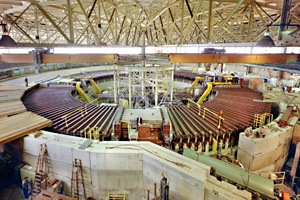 Inside the Bevatron. Credit: Lawrence Berkeley National Lab.
Inside the Bevatron. Credit: Lawrence Berkeley National Lab.
Much as I tried to get Stewart Loken to wax poetic about the demise of the Bevatron, the truth is that he – and, I'll bet, a lot of scientists – just don't think that way.
As Loken put it, "science never stands still." However many Nobel prizes the Bevatron produced, this old, defunct particle accelerator is really just taking up space; its demolition, and replacement with a new, up-to-the-minute research facility, is, Loken feels, the best way to honor the work done here. Plans aren't finalized, but it's likely the facility to replace the Bevatron will forward work done at Lawrence Berkeley National Lab's Advanced Light Source (which, by the way, produces light a billion times brighter than the sun).
The new facility – described here – would allow scientists to watch "electrons joining forces, atoms snapping together within millionths of a billionth of a second, the real time of chemical reactions."
But that's a long way off. First, demolition workers must contend with a major disposal challenge, including getting rid of radioactive waste produced during experiments at the Bevatron. Some neighbors are concerned about the prospect of hauling the stuff through Berkeley's residential areas. Others have called for the Bevatron to be preserved as a national landmark.
